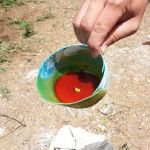Application of Lime Sulfur to control Coffee Rust
Applying a lime sulfur mix (‘caldo’ in Spanish) to coffee leaves creates a physical barrier to prevent rust spore germination and/or penetration into the leaf tissue. The treatment will not work to halt an aggressive outbreak but may prevent or slow down disease development if applied at the right time.
Status: Lime sulfur has been widely used on many crops in the past, but in recent years has been mostly replaced by modern but more expensive fungicides. Use of lime sulfur for rust prevention is currently under testing by c&c in Central America (see case study), with positive results.

Concept
Lime sulfur – a product based on sulphate and calcium oxide, both ingredients used to control pest and diseases – is a low-cost alternative to fungicide that can be used as part of a rust management plan. Lime sulfur is best used preventively; if the incidence or attacked area of affected trees is already higher than 10%, a systemic fungicide is necessary.
Drawbacks
- Could damage leaves if dose is too strong, because it is highly alkaline.
- Smelly. Lime sulfur reacts with strong acids to produce highly toxic hydrogen sulfide and usually has a distinct “rotten egg” odor. Lime sulfur is not extremely flammable but combustion produces highly irritating sulfur dioxide gas.
- Can cause physical harm. Lime sulfur solutions are strongly alkaline (typical commercial concentrates have a pH over 11.5), and so it is corrosive to living things and can cause blindness if splashed in the eyes (from Wikipedia). Safety goggles and gloves should be worn while handling lime sulfur.
Costs
- Less expensive than other fungicides (a typical fungicide might cost 40 USD/ha, wherease lime sulfur costs about 10 USD/ha), but may be less effective.
Recommended Activities
- Do not apply lime sulfur when the plant is flowering – apply 20-40 days after the main flowering.
- Apply before symptoms of a rust outbreak are evident.
- Mix calcium oxide or hydroxide, sulfur, ash and heated water in a metal container.
- Test the prepared mixture on one or two branches and inspect later for leaf burn – if so, dilute the mix further and re-test.
- Apply the mixture to rest of your crop liberally.
Further Activities
- First used in the 1840s in France to control grape vine powdery mildew – quite widely used until the 1940s when synthetic fungicides replaced it.
- A field study on blackberry rust showed that lime sulfur applied as a delayed dormant treatment significantly suppressed teliospore germination and basidiospore infection.
Further reading:
- Johnson, K. B., & Mahaffee, W. F. (2010). Factors influencing epidemiology and management of blackberry rust in cultivated Rubus laciniatus. Plant disease, 94(5), 581-588. Ramsay, A. A. (1914).
- The Preparation and Composition of Lime-Sulphur Sprays. The Journal of Agricultural Science, 6(02), 194-202.
- Have something to add to this tool description? Leave a comment!
- Interested in applying this tool? Look for pictures, case studies and info sheets below for step-by-step instructions to get you started.






Leave a comment
0 comments